A few months ago, I released an article discussing my preferences and experiences regarding the best disposable respirators on the market. In that article, I discussed over 25 respirators that are all certified and easily available. However, I included only filtering facepiece respirators (FFRs) in that article and didn’t touch on half-face respirators (sometimes called half-mask or half facepiece respirators).
Today I want to remedy that by discussing my favourite elastomeric half-face respirators. I’ve recently been reviewing a few of these devices, and I figured it would be best to aggregate my findings in one place. Please keep in mind that I’ve only listed half-face respirators I’ve tried – there are many more on the market, but I don’t yet have first-hand experience with them.
My main aim in this article is to share my experiences with a range of half-face respirators. I will go over which devices fit the best, which have the best range of filters, and which are the most comfortable to wear. I will also discuss which respirators I’ve found to be best overall.
Before jumping into the article, there are a few disclaimers that I need to make. Please make sure to keep these in mind when reading the list.
- I am not an expert on respirators. I am writing this article from my personal experiences wearing each device.
- If you use any of these devices in a medical, industrial, or otherwise occupational environment, refer to a professional for advice and guidance.
- For these devices to be effective, professional fit-testing is required.
On top of this, I want to note that my thoughts today are regarding each half-face respirator in its particulate filtration setup. While many respirators on this list can also use gas and vapour filters, these are out of the scope of this article. Instead, the thoughts I’ve shared are from my use of each respirator with N95-P100 filters or cartridges.
These are the configurations in which most individuals will use half-face respirators, so I decided it would be best to discuss them. Further, some half-face respirators included only feature particulate filters meaning they aren’t comparable to devices with big ecosystems such as the 3M 6000 series.
Subscribe to BreatheSafeAir
Air pollution is a silent killer that affects millions of people worldwide. Start protecting yourself today.
This post contains affiliate links. For more information, please refer to my affiliate disclaimer.
Information on this blog is for informational purposes only. Readers are encouraged to confirm the information herein with other sources. Furthermore, this information is not intended to replace medical advice from professionals. This website assumes no responsibility for the accuracy of the information, which is subject to change without notice.
Why Purchase a Half-face Respirator?

If you came across this article because you are seeking a half-face respirator, you’re likely already aware of the benefits of a half-face respirator over a filtering facepiece respirator (such as a disposable N95). If this is the case, please feel free to skip this section. However, if this article is your introduction to half-face respirators, I will briefly cover the benefits of these respirators here.
Although both FFRs and half-face respirators are air-purifying respirators (meaning they remove contaminants from the air before they reach the wearer but do not supply oxygen), there are some key differences between the two. It’s important to note that a very large range of FFRs and half-face respirators are available; therefore, these advantages are generalisations typical of the respirator class.
Fit – Half-face respirators tend to provide a better fit due to the more lenient nature of the rubber seals used. This means they are more likely to fit any given individual and maintain a better seal when worn. While there are exceptions, studies have shown that elastomeric half-face respirators fit a wider variety of individuals without leaks.
Protection – As the CDC states, elastomeric half-face respirators offer at least equivalent or more protection than N95 FFRs. While the exact protection will depend on the respirators in question, many half-face respirators offer better filtration and fit than their FFR counterparts.
Flexibility – Many half-face respirators are flexible in the protection they offer. Every half-face respirator on this list offers particulate filters ranging from N95 to P100, but many also offer filters for various gases and vapours. This makes half-face respirators more flexible in the protection they offer, as FFRs only offer particulate filtration.
Reusable – Half-face respirators are designed to be reused hundreds if not thousands of times. Where FFRs are intended for only one use, half-face respirators have user-replaceable filters. Further, these replaceable filters often have longer lifespans – for example, the ElastoMaskPro filter can last for more than six months of daily usage.
Seal-checking – All NIOSH-certified devices are designed to be coupled with professional fit-testing. However, for general consumers without access to fit-testing, half-face respirators often provide far more accessible and effective-seal checking. Covering the valves and filters makes doing positive and negative seal checks on these respirators significantly easier than FFRs, where the whole surface area is usually the filter.
Washable – If you plan to reuse a half-face respirator often, you’ll be happy to know that most of them are easily washable. Removing the filter cartridges leaves you with a plastic and rubber mask that can easily be hand washed and sterilised.
What to Look For in a Half-Face Respirator
Filters & Cartridges

Purchasing a half-face respirator is a different process than purchasing a filtering facepiece respirator (commonly called a disposable respirator). With FFRs, you are purchasing a disposable device complete with a filter. This means when purchasing a respirator such as the 3M 1870+, you are getting a complete N95-approved product.
On the other hand, NIOSH does not approve half-face respirators unless they are used with the correct pieces. For example, a half-face respirator itself is not in an approved state unless it is paired with filters or cartridges that have been approved for use with it. While this might seem like an added level of complexity (and perhaps it is), it does come with advantages,
Since many elastomeric half-face respirators are designed for various purposes, many brands offer a range of filter types. For example, a respirator could have N100 and P100 filters alongside various vapour and gas filters designed to work against various particles and chemicals. While the filters must be specific for the intended purpose of the respirator, this means half-face respirators tend to be far more versatile devices.
While you usually will have to purchase filters for half-face respirators separately, you can tailor the filters to fit your needs. For some respirators, you will even have choices regarding which particulate filter to use, meaning you can focus more on breathability or filtration – a nice choice to have!
Not all half-face respirators offer a range of filters, however. On this list, devices such as the GVS Elipse and ElastoMaskPro offer only particulate filters. I’ll discuss the filters available for each respirator on this list, but it’s important to ensure you buy a respirator with filters that fit your needs.
Valves

Most half-face respirators are industrial-focused devices, so many manufacturers choose to add valves to decrease exhalation resistance for the wearer. Unfortunately, when it comes to protection from COVID-19 and other illnesses, two-way filtration is key to preventing the spread. For this reason, it’s important to consider whether valves are important or not.
Although most half-face respirators are industrially-focused, more and more medically-focused half-face respirators are appearing on the market. To be used medically, respirators must filter particles both ways, as source control is as important as filtering inhaled particles. On these devices, you won’t find valves.
However, although COVID-19 has seen more valveless devices introduced, they are still far rarer than valved devices. In fact, there are currently only six manufacturers certified by NIOSH to produce non-valved particulate-filtering elastomeric half-face respirators.
When purchasing a half-face respirator, it’s important to consider if you need valves or not. If you’re planning to use a half-face respirator for DIY work, you will likely benefit from having a valve. However, if you want to use the mask as protection from viruses, you’ll want to ensure no valve is present.
Some respirators, such as 3M’s 6000 series, feature valve-filter attachments. These attachments can be added to the half-face respirator to add filtration to an exhalation valve. However, while these can provide some level of two-way filtration, it’s important to note they aren’t NIOSH certified, and the respirators are still treated as having a valve for approval purposes.
Sizing

While this may seem obvious, it’s also something that can easily be overlooked – make sure to get a half-face respirator in the correct size! While some models only come in one size, most offer different sizes for different individuals.
Often, these devices will also have different model numbers. For example, 3M’s 6000 series consists of three devices – the 6100, 6200 and 6300. All of these respirators are the same; however, each consecutive model is larger than the one before it. While a 3M 6200 fits me well, you may need a 6100 or 6300.
Unfortunately, there is no universal sizing system, and it’s not always easy to tell which size is the best choice before purchasing. If you’re unsure, I recommend checking out the manufacturer’s website, as these often have sizing guides.
If sizing guides aren’t present, there are some communities online where you can ask for sizing advice. A great community is Masks4All on Reddit. While it’s impossible to figure out the intricacies of fitting without physically having the device, other reviews and opinions can help point you in the right direction for finding the right size.
Breathability
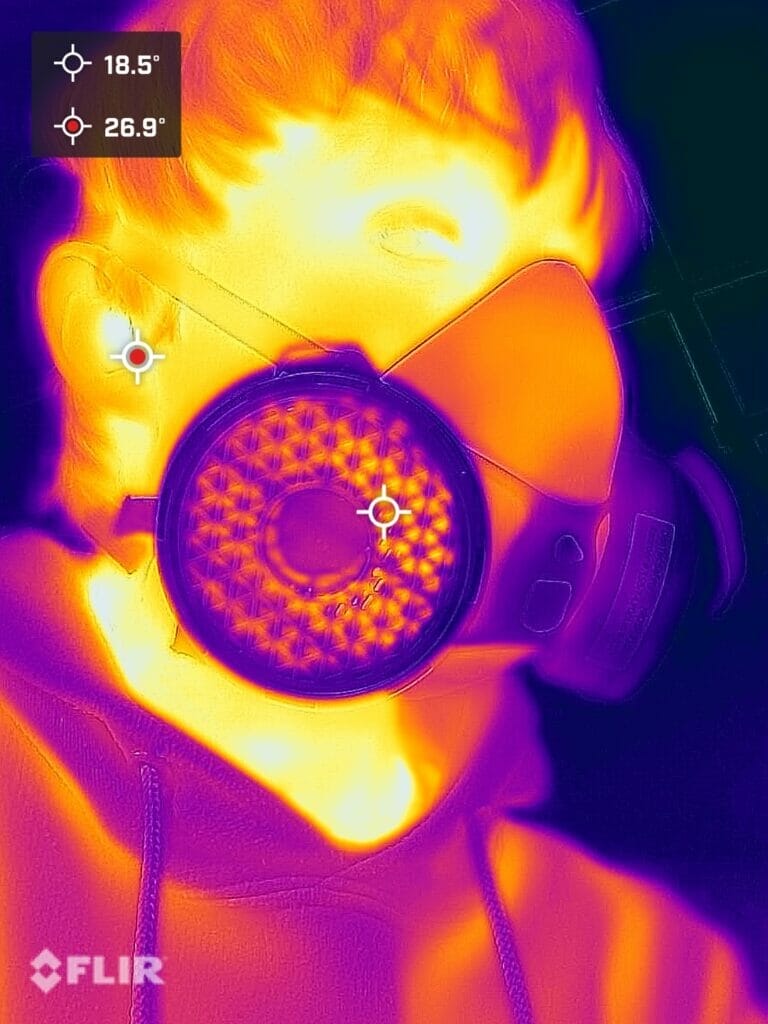
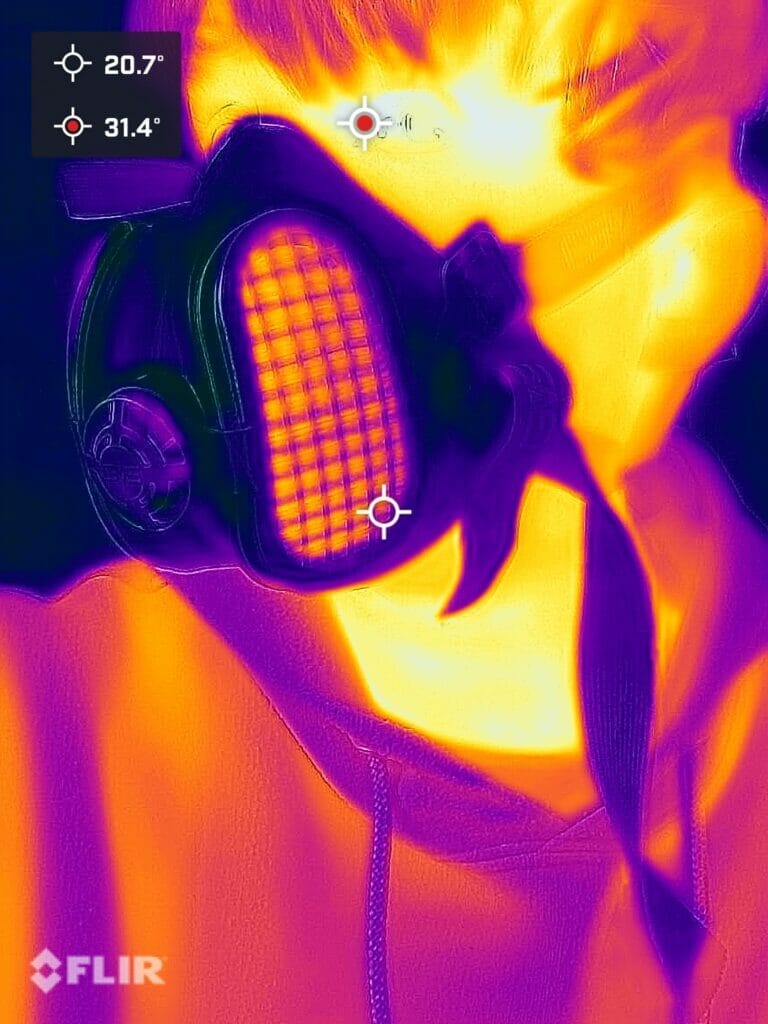
From left: Active filtration surface area on Dentec Comfort Air, GVS Elipse. Photos taken with Flir One Pro.
Breathability is another core concern when it comes to half-face respirators. Being the primary component of comfort, the breathability of a respirator will dictate whether or not the device is comfortable to wear for short and long periods.
Generally, as the filtration efficacy of filter media increases, the breathability decreases. However, this isn’t always the case, and there are methods to offset the increase in pressure drop (decrease in breathability). The most common method seen in elastomeric half-face respirators is pleated filters, which results in a larger filter surface area.
Another common method to increase breathability is to increase the physical filter or cartridge size. For example, I found the Dentec 400NxMD to have exceptional breathability. The secret? To have comparatively massive filters that are pleated to provide maximum surface area.
Breathability for respirators is measured both for inhalation resistance and exhalation resistance, both of which are measured in pressure drop. This is the pressure differential between the two sides of the filter as air flows through it. To put it simply, the differential represents the difficulty a wearer will have inhaling and exhaling through the filter medium used in the elastomeric respirator.
Breathability will either be measured in mmH2O or Pa. One pascal equals approximately 9.8mmH2O, and the upper limit for an N95 respirator is 35mmH2O or 343Pa. Without getting too complex, you will want to look for lower pressure drop filters and devices wherever possible, as this will be significantly more comfortable.
For a point of reference, most popular N95 FFRs have inhalation and exhalation resistance ranging from 8-15mmH2O. Anything lower than this would be considered exceptionally breathable, while respirators with higher breathing resistance may be uncomfortable for some and aren’t ideal for wear during exertion.
It is worth noting that many elastomeric half-face respirators have a significantly lower exhalation resistance due to the inclusion of an exhalation valve. These allow air to exit the mask unfiltered, therefore greatly decreasing resistance. However, inhaled air still needs to be filtered, so a greater pressure drop will be present.
Comfort
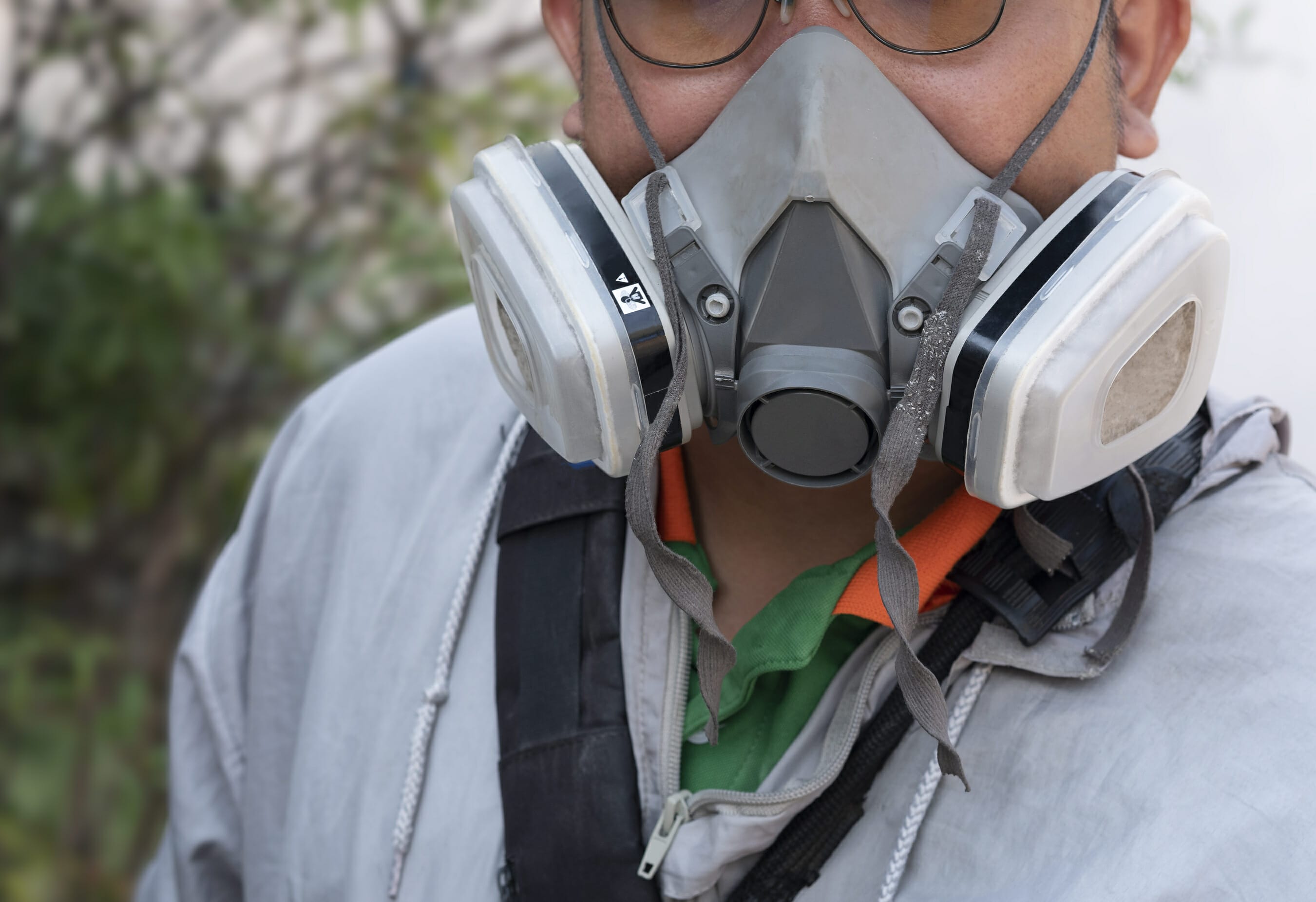
Alongside filtration and fit, comfort is one of the three core pillars of respirators. While filtration and fit apply directly to the performance of a half-face respirator, comfort dictates whether you actually want to wear the product or not. In the end, wearing any half-face respirator is better than wearing none. This is where comfort becomes vital.
The most important aspect of comfort is breathability, and it’s so important that some people consider breathability to be the third pillar of respirators as opposed to comfort as a whole. However, I prefer to focus on comfort as its own pillar because other contributing factors impact if a respirator will be comfortable or not.
Unfortunately, it’s hard to predict if a half-face respirator will be comfortable before purchasing it. Ideally, the best way to judge comfort is to try a range of respirators and see what suits you best. However, this isn’t always possible and can lead to wasted money.
Luckily, there are a few ways to judge the comfort of a device before purchasing it. Firstly, the headbands make a big difference. Thicker headbands tend to be not only more comfortable but also tend to provide a more secure fit.
The weight of the device plays an equally large role in predicting whether a half-face respirator will be comfortable or not. Heavier devices tend to be (but aren’t always) less comfortable to wear – especially when worn for long periods of time. It’s also important to consider the weight of the filter cartridges, as these can significantly increase the weight of a half-face respirator.
Another aspect worth considering is the material and feel of the seal. While identifying the softness of the seal isn’t easy without trying a product, there is a wealth of reviews on the internet for most respirators. I highly recommend reading through some of these and looking into whether or not a mask has a comfortable seal, according to other individuals who have tried it.
Comfort is subjective, and deciding whether a respirator will be comfortable or not is often difficult before purchasing it. However, I hope these tips can make selecting a comfortable respirator slightly easier!
Lifespan & Cost
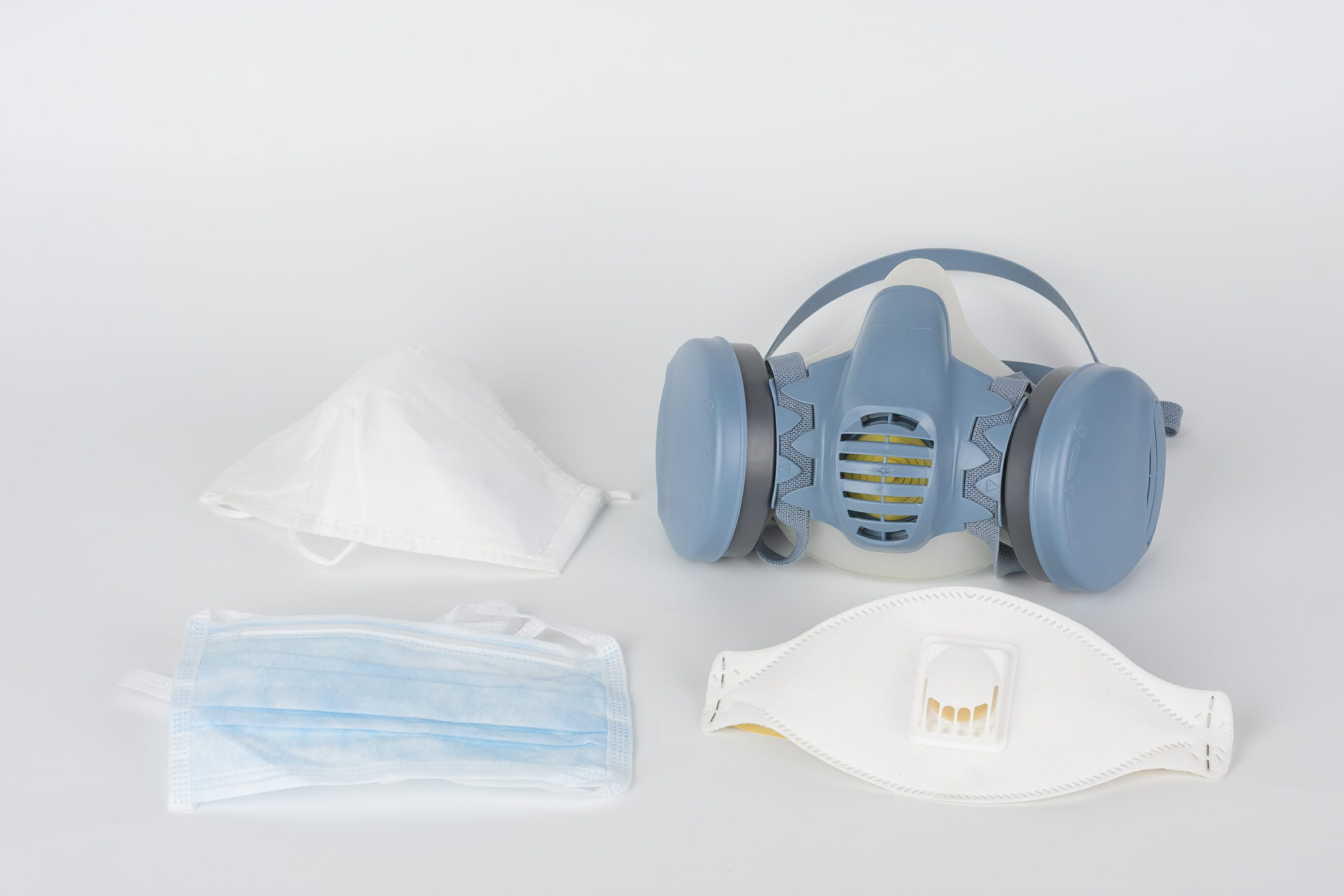
Considering the lifespan of half-face respirators is a very different process from filtering facepiece respirators. Lifespan is an important consideration with all respirators because it directly affects the costs involved – a cheap device with a long lifespan is a far more cost-effective PPE approach than an expensive device requiring regular filter replacements.
Unlike most FFRs, half-face respirators don’t need to be replaced. The respirators are usually a combination of plastic, rubber, and silicone, built to last for many uses. Unless your respirator gets badly damaged or is stored incorrectly, it should last for years of use. For this reason, half-face respirators often cost a premium, and their prices normally range from $20 – $100.
Therefore, the biggest consideration regarding the ongoing costs of a half-face respirator is the price and lifespan of the filter cartridges you will use. Many particulate filters will cost $10 – $20, but they will last for many hours of use. This starkly contrasts FFRs, where a single respirator will cost a couple of dollars but require regular replacement.
Since half-face respirators are usually a long-term investment, you might want to consider higher-end devices such as 3M’s 7000 series of ElastoMaskPro. These devices cost close to $100, but since they are built to last, the investment will be justifiable for many people – especially if the respirators fit better or are more comfortable.
Before purchasing a respirator, also make sure to check the filter specifications. How long is each filter rated to last, and how much do replacements cost? These factors will greatly influence the ongoing costs of owning a half-face respirator and are worth considering before deciding which device to purchase.
Best Half-Face Respirators
3M 6000 series

Brand: 3M
Filter Types: Particulate (P100), gases, vapours
Valve: Yes (can be filtered with the optional 3M 604)
Filter Attachment: Bayonet
The 3M 6000 series is likely the most popular half-face respirator on the market. Although there are three different models in this series, all models are identical, with the number representing the device’s size. The 6100 is the smallest of the three, the 6200 sits in the middle, and the 6300 is a large device designed for larger faces. In many ways, these respirators have created the standard for what we expect when discussing half-face respirators.
3M does offer the 7500 range of half-face respirators. These respirators are more expensive and more comfortable to wear for long periods due to a softer seal. I don’t currently have one on me, so I will only be discussing the 6000 series in this article. With that being said, the 6000 series tends to be the more popular range due to these respirators’ more affordable price tag.
With 3M being the largest respirator manufacturer in the world, buying into the 3M ecosystem is a good choice for half-face respirators. The range of filter cartridges available for these devices is extensive and second to none. Whether you are seeking protection against organic vapours, gases, or particulate matter, 3M has cartridges on offer. This massive range of filters means that these are the most flexible respirators on this list regarding the protection they offer.
I’ve always found the 6200 (the respirator I opted for) to fit exceptionally well. While I haven’t had any half-face respirators fit me poorly, some fit better than others. The 6200 is one of these respirators. The large inner fold of the silicone seal ensures that it always seals well around the bridge of my nose and under my chin. The head straps are solid, and the plastic brace means that the respirator doesn’t slide down my face when worn for long periods.
As with almost all half-face respirators, the 6000 series have an exhalation valve. This means that the device will provide only one-way filtration and, without specific attachments, will not provide source control. This choice makes sense since these devices are designed mainly for industrial uses. While an exhalation filter (3M 604) can be purchased, these filters have only been tested for bacterial filtration efficiency (BFE) and are not FDA-cleared as medical devices.
My biggest gripes with the 6200 are the somewhat uncomfortable headband latch and the size of the respirator when matched with covered P100 cartridges such as 7093 filters. While 2000 series filters (non-covered) are significantly smaller and lighter, I prefer to use half-face respirators with covered cartridges for the extra protection they offer the filter.
Overall, the 3M 6100, 6200 and 6300 are great devices. They fit well, at least for me, and they remain comfortable even when worn for long periods of time. However, their true strength is revealed in the incredible flexibility that they offer when it comes to filter types.
Purchase 3M’s 6000 Series Respirators
Honeywell RU8500X
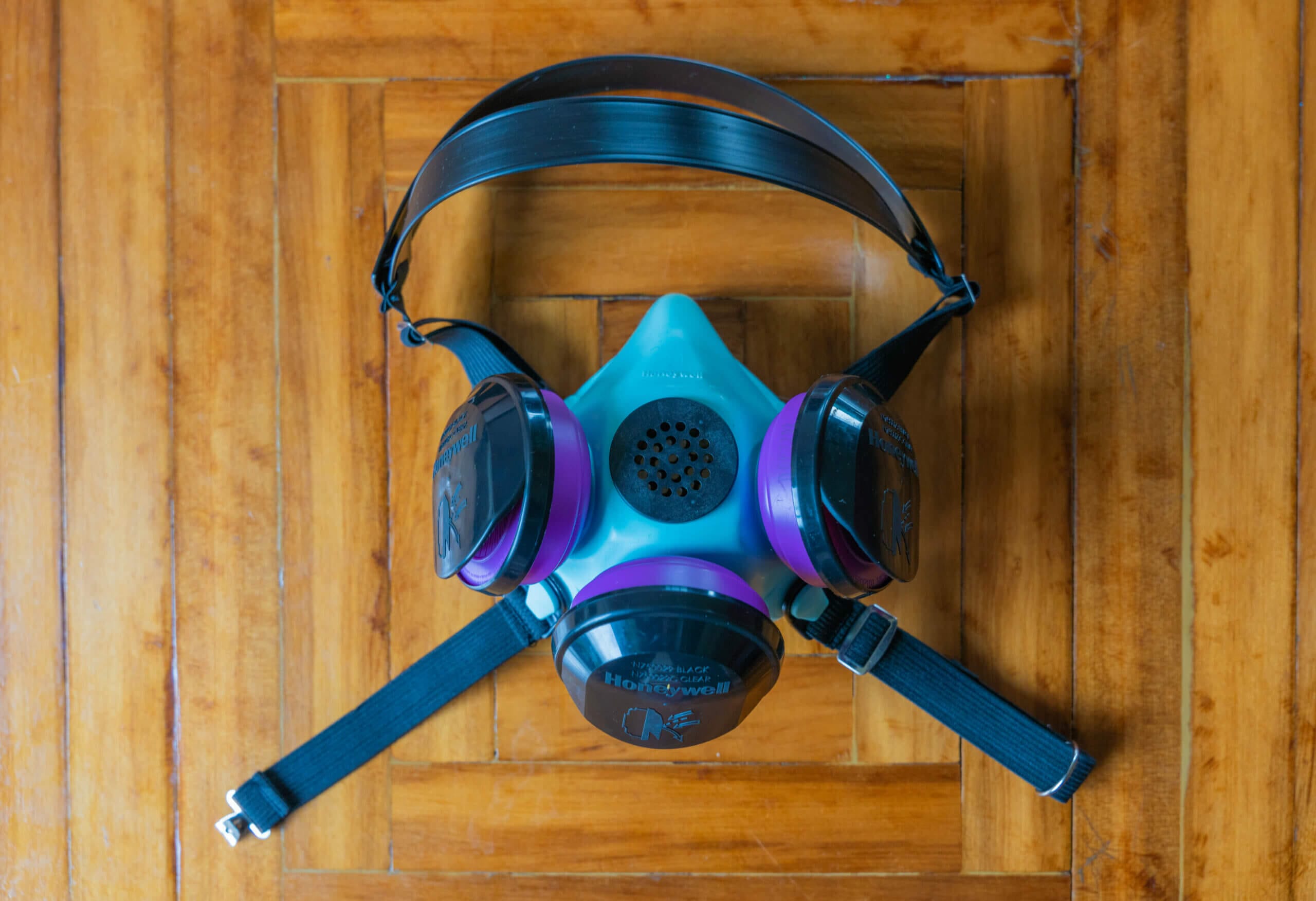
Please note: the image above shows an RU8500X. These are the same as the RU8500, but feature a filtered exhalation valve.
Brand: Honeywell
Filter Types: Particulate (P100), gases, vapours
Valve: Yes (RU8500), No (RU8500X)
Filter Attachment: Bayonet
As the second largest respirator manufacturer in the world, Honeywell also has a range of entries in the elastomeric half-face respirator world. For this list, I will take one of my favourites, the RU8500. This respirator is a more premium half-face respirator and often costs double or more than the 3M 6000 series.
That begs the question – is the extra cost worth it? Well, depending on your values, it definitely could be. When fully equipped with P100 filters such as the 7580P100, the Honeywell respirator does become quite heavy, definitely more than the 6200 with similar filters attached.
Despite the respirator being heavier, it feels similar in regards to comfort. This is likely due to the more compact profile of the device as well as the better breathability. While it depends on the filters in question, I found the Honeywell respirator more breathable with three 7580P100 cartridges than the 3M 6200 with 7093 cartridges.
This meant that I often preferred to pick the Honewell half-face respirator instead of the 3M version. Although I find the fit on the 6200 slightly superior (in my case), I prefer the build quality of the Honeywell product. The comfort is also very similar, but I would lean towards the RU8500 most of the time due to the better breathability.
The RU8500 features a brace at the top of the upper headband to assist in keeping the respirator in place even during active work. The straps are thick, which means that the respirator’s weight is well distributed across the wearer’s head, preventing any serious strain from being placed in a single area.
The clips on the lower headband on the RU8500 are incredibly simple, which is to the product’s benefit. The clips are comfortable, and I never had any issues with them digging into the back of my neck or otherwise causing discomfort. The seal material is also quite soft, ensuring that the mask doesn’t dig into your face or skin.
Honeywell heavily advertises the speech diaphragm technology on this respirator. Essentially, the company claims they designed this product to not interfere with speaking. Anyone who’s worn a half-face respirator before knows how challenging communicating can be, and any innovations in this aspect would be greatly appreciated.
While the difference isn’t vast, I think Honeywell has put in a good effort in this regard. Speaking in the RU8500 feels not only easier but clearer. People had less of an issue hearing me with this respirator as the distortion is lowered significantly enough to make a difference.
While Honeywell offers some organic vapour and particulate cartridges, the selection is less than 3M. Further, sourcing the different cartridges online is significantly more difficult – especially if you are looking for something more than an N series particulate filter. For this reason, the flexibility of the RU8500 is significantly less than 3M’s offering.
Overall, the Honeywell RU8500 is a premium feeling half-face respirator with fantastic build quality. The mask is heavy, but the thick headbands keep it fitted well even when active. Breathability is improved compared to most half-face respirators on the market.
Purchase Honeywell RU8500 Respirator
GVS Elipse
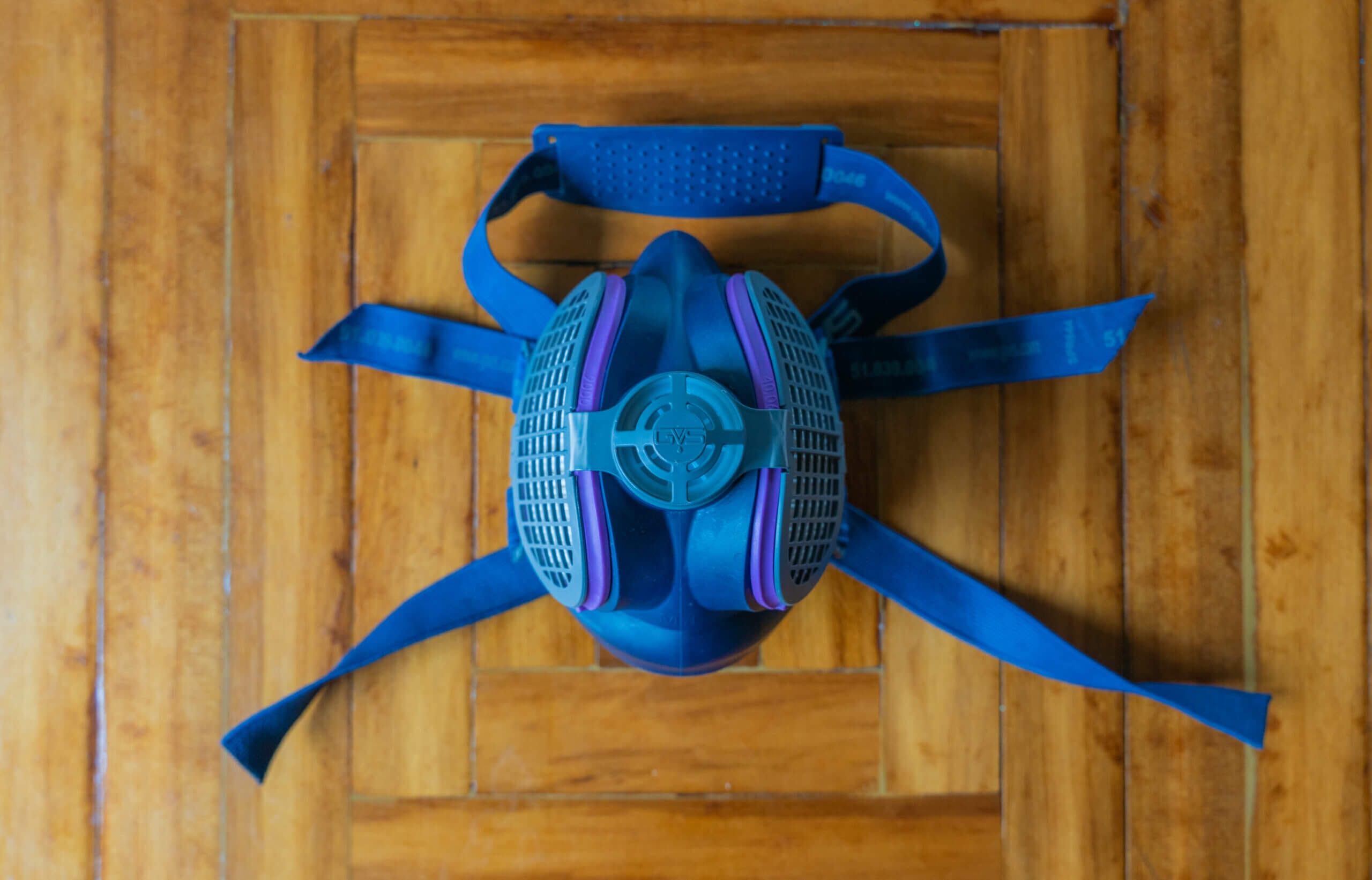
Brand: GVS
Filter Types: Particulate (P100)
Valve: Yes (valveless model available)
Filter Attachment: Slot-in
The GVS Elipse is a half-face respirator quite different from ‘typical’ half-face respirators. Rather than utilising filter cartridges that attach via bayonet externally, the GVS Elipse is a more compact respirator with user-replaceable internal filters. While this has some downsides, it means that the respirator has a smaller form factor, and you don’t need to worry about the cartridges getting caught when working in tight spaces.
The downside that I mentioned is the GVS Elipse only features particulate filters. Where the 3M and Honeywell devices have a larger ecosystem of parts and filters, GVS has focused this half-face respirator purely on users who only need particulate filtration. GVS offers the best filtration possible in this area with NIOSH-approved P100 filters.
Despite the very large surface area of these filters (SPR321), I found the breathability of the GVS Elipse to be on the lower end of the elastomeric half-face respirators on this list. The MSA Advantage 290 and Honeywell RU8500 offer significantly lower pressure drops, making the respirators more comfortable to wear. The difference between the 3M 6200 and GVS ellipse isn’t as great, but I still feel the 3M product offers better breathability.
Where the GVS respirator gains some ground is in other comfort-related aspects. The device is small and relatively light, especially compared to the RU8500. It has oversized headbands that are both comfortable and capable of distributing the respirator’s weight well. The lack of a clip also means no source of irritation or discomfort in the back of my neck.
Although the GVS filters don’t come with any coverings or protection, the mask has a built-in mesh that will prevent the filters from being damaged by large objects. While this is fine for most applications in which the device will be used, I appreciate the filter covers that other brands offer – even if only for peace of mind.
The seal of the GVS Elipse half-face respirator is also an area where it differs from other products in this segment. Where most competitors opt for a rounded triangle seal, GVS has instead chosen a more ovular seal. Initially, I believed this wouldn’t fit as well. However, after wearing the respirator while working under the house, I found the seal worked very well.
To achieve a solid seal, I did need to move the half-face respirator up my face compared to where I would position a triangular-seal device. Once I discovered this slight difference, I achieved a seal that was at worst equal to the 6200. I generally found the seal to perform better, as the device is smaller and less prone to micro-movements when worn.
Although the GVS Elipse is a less flexible respirator due to the lack of different filter cartridges, I found this half-face respirator to be my go-to for DIY work around the house. While it does have lower breathability, I generally wasn’t heavily exerting myself in these situations. Instead, the smaller form factor and great fit of the respirator made it a good choice.
Purchase GVS Elipse Respirator
MSA Advantage 290
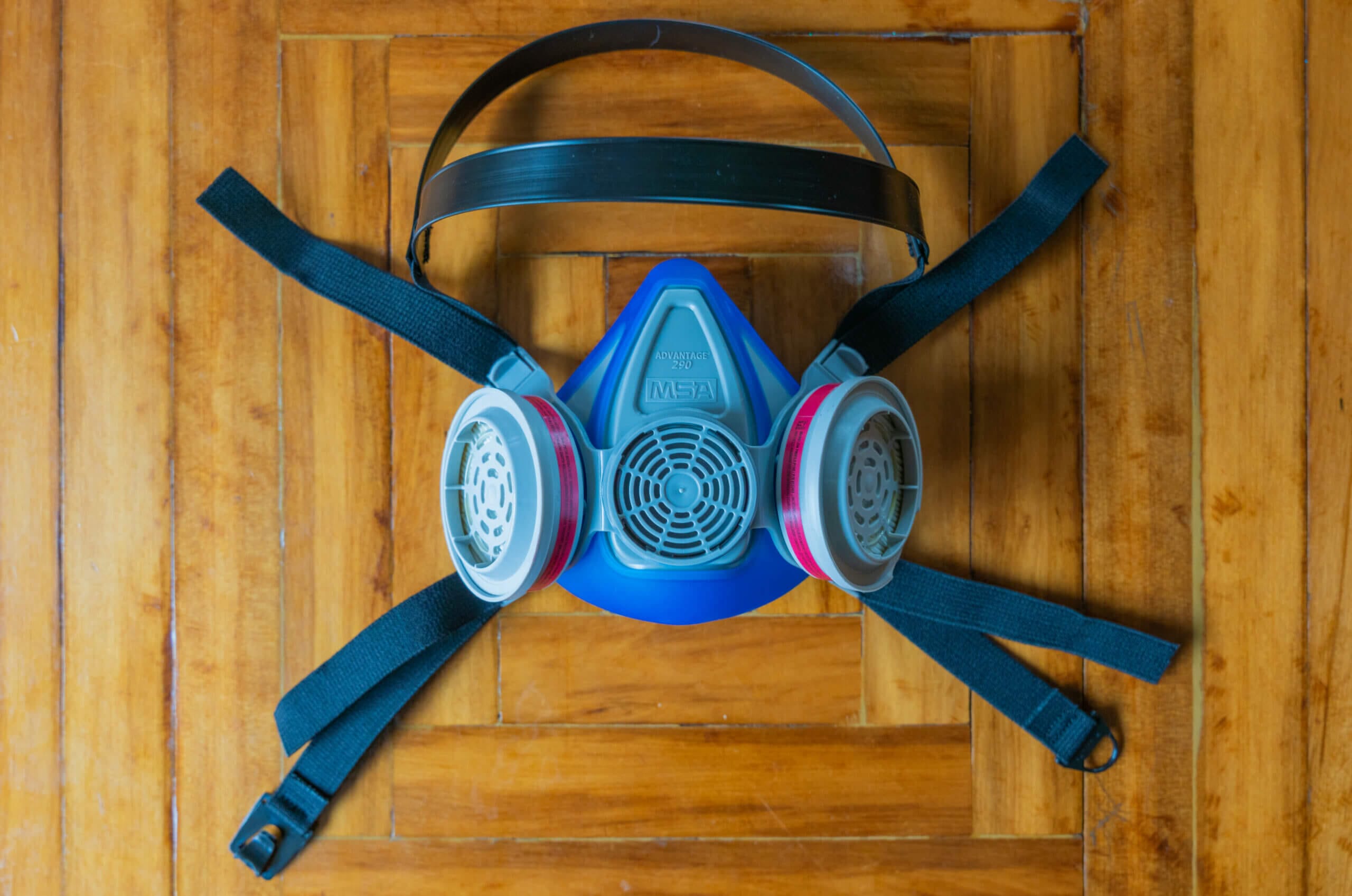
Brand: MSA
Filter Types: Particulate (P100) (other Advantage models have more extensive selections)
Valve: No
Filter Attachment: Bayonet
The MSA Advantage 290 is an interesting half-face respirator because it’s one of the few on this list designed for medical professionals. On top of the other benefits of elastomeric half-face respirators, the Advantage 290 also offers source control by removing the exhalation valve often found on industrial-focused respirators.
Due to this, the Advantage 290 is in a similar situation as the GVS Elipse. While MSA does offer an extensive range of cartridges for vapours and gases, these are not designed to be used with the Advantage 290. Therefore, this device is solely designed to be used with particulate cartridges such as the MSA 815303.
The Advantage 290 is very similar to the Advantage 200, but the lack of an exhalation valve differentiates these two products. Although the 290 looks like it has a valve, there is no opening on the interior of the respirator. Therefore, while the device may be mistaken for having a valve, there is nowhere for the air to exit the mask besides the two side-mounted filters.
Despite the lack of an exhalation valve, the Advantage 290 has low exhalation resistance, and I didn’t find myself ever missing the valve. In fact, I didn’t even notice the respirator didn’t have a valve. While exhalation resistance is lower on the half-face respirators with a valve, this difference is much less impactful than a difference in inhalation resistance.
The Advantage 290 features a deep-set chin area that allows the half-face respirator to seal around your jaw line and sit and seal underneath it. Although I didn’t find this to make much of a difference in regards to fit, I did find that it kept the device in place better than other respirators when I was active.
Combined with the relative lightness of the respirator (at least in comparison to the 6200 with 7093 filters and the Honeywell RU8500), this allowed the Advantage 290 to almost always stay in place on my face. I found this respirator to slip and move less than other respirators, even when I was active.
This excellent fit is assisted by the double-plastic headband similar to the aforementioned respirators. With the respirator seated by bands both above and behind the head, it can maintain a solid fit that remains comfortable even when the wearer is physically active and moving.
The flat clip design used to connect the two neckband portions is very comfortable, and I never had any issues with discomfort in this respect. So long as the flat side of the clip sits against my neck (as it is intended), I barely even noticed the clip was there. This is how a neck clip should be made!
I also appreciate the easy seal testing on this half-face respirator. Although I will admit this depends on the filter in question, the Advantage 290 is far easier to seal-check than the 3M 6000 series (with 2000 series or 7093 filters), Honeywell RU8500 (with filter covers) and GVS Elipse. The circular design of the filter cartridges on the Advantage 290 makes the filters exceptionally easy to cover with your hands leading to straightforward fit-testing.
The biggest downside of the Advantage 290 is its limited selection of filter cartridges. However, if you are using the respirator in a situation in which P100 filters will suffice, this is a great choice of respirator. The excellent breathability (even when lacking a valve), good comfort and ease of seal-checking make it a half-face respirator worth considering.
Purchase MSA Advantage 290 Respirator
Stealth Respirator Dust Mask
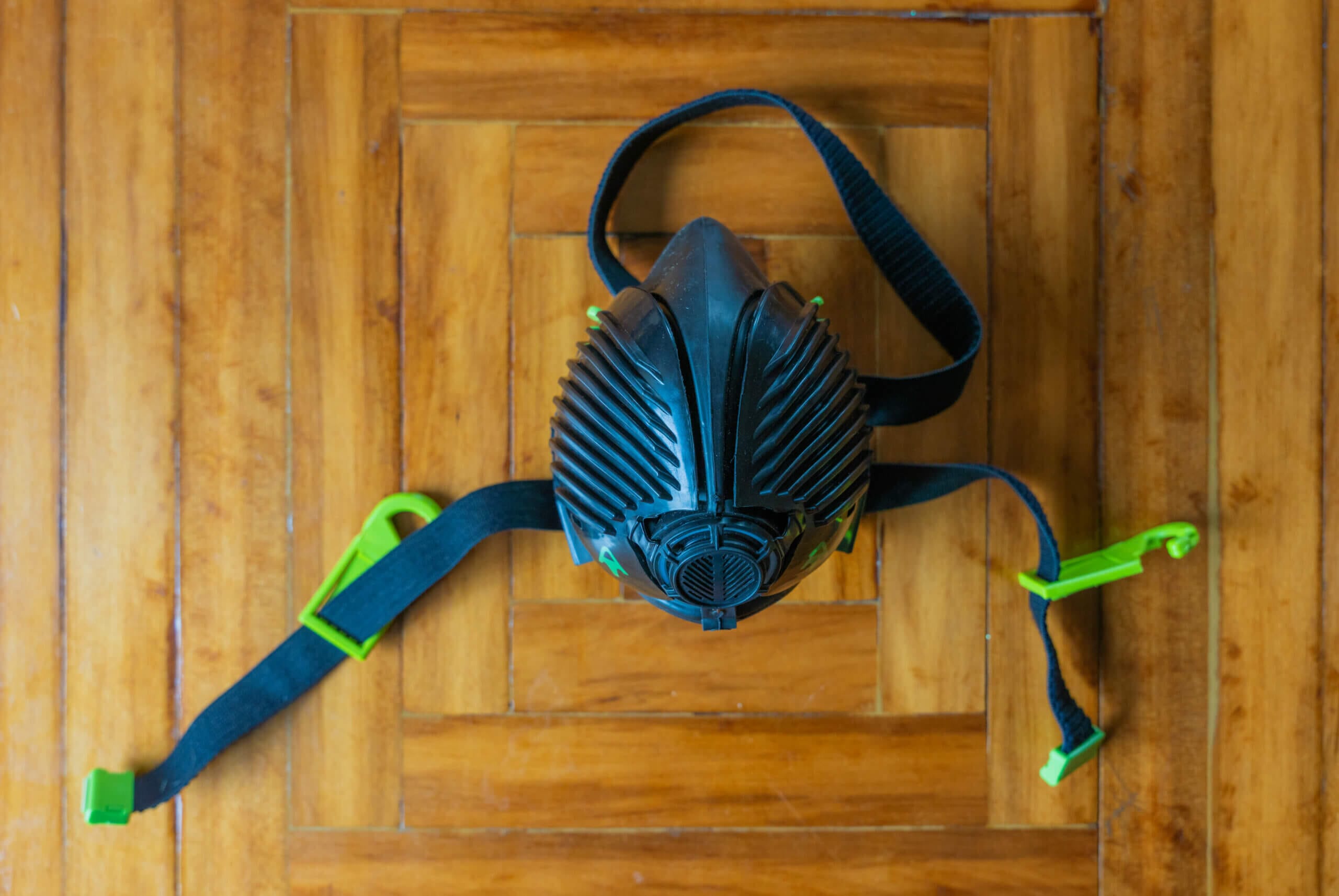
Brand: Air Filtration Solutions
Filter Types: Particulate (N100 or P100)
Valve: Yes
Filter Attachment: Slot-in
The Stealth Respirator Dust Mask (which I will refer to as the Stealth Respirator) is perhaps the most interesting respirator on this list. The design makes the respirator look like an aggressive insect – perhaps a wasp? – and the respirator is significantly smaller than the larger devices with external filter cartridges.
I did an in-depth review of the Stealth Respirator and shared my full thoughts on the product there. If you are interested in this device, I recommend checking out that post as I dive into more detail there. That said, I will share the essentials here so you can decide if this half-face respirator is worth considering.
The most obvious difference with the Stealth Respirator is the size. Much smaller than the 3M 6000 series and RU8500, the Stealth Respirator is far closer to the GVS Elipse in size. The overall design of the product is also very similar from the outside. However, when you see the inside of the respirator, they become vastly different.
The Elipse has a significantly larger chamber, meaning I never had issues with the inside of the respirator touching my face. On the other hand, I often feel the interior of the Stealth Respirator touching my face – especially as I inhale. While this isn’t a big issue, I would love to see the respirator updated with a bigger chamber.
The reason for the small chamber is that the filters for the Stealth Respirator sit inside the mask. The team behind the Stealth Respirator opted to place the filter inside the mask shell where GVS has thickened the area where the filters sit. The shell quickly becomes very thick with interior inhalation and exhalation valves, causing the chamber volume to decrease.
Stealth Respirator uses internal filter media pairs in either N100 or P100 variants. I have not tried the P100 filters, but I’ve found the N100 filters to perform well and to be breathable enough not to cause discomfort. With the N100 filters, I would say that breathability isn’t noticeably different to the Elipse with P100 filters. That said, a fairer comparison would be comparing both half-face respirators with P100 filters which I can’t currently do.
This half-face respirator does feature a centrally-located exhalation valve which means it doesn’t offer source control. There is also currently no way to close, disable, or otherwise filter this valve. However, this choice makes sense since the respirator is designed for workshop and DIY use. This is not the respirator for when source control is needed – the ElastoMaskPro and Advantage 290 are better in these situations.
Similarly to the GVS Elipse, the Stealth Respirator uses a more oval seal than the triangular seals on the larger respirators. I rarely had issues with the seal leaking, and these were easy and quick to fix when they did occur (usually because the device had slipped down my face ever so slightly).
The headbands on the half-face respirator are comfortable, and I never had any issues with the upper headband. Unfortunately, the overly large clip on the lower headband is not particularly comfortable. Even when the clip is sitting right (with both clips in their slots), the plastic can cause irritation as it sits against my neck. It’s not the end of the world, and sometimes I don’t notice the issue. However, there are other times when I simply can’t get the clips to sit as they should.
The seal is soft enough to remain comfortable even after long wear. I found the seal to be more comfortable than other half-face respirators, which tend to rely on more sturdy seals, and this meant that I often returned to the Stealth Respirator.
This respirator will muffle your voice even more than the larger half-face respirators such as the 3M 6200. I believe it’s due to the small chamber in the mask, but speaking through this mask almost makes my voice sound robotic. Although this isn’t a big deal for many, I would appreciate it if this could be improved as many respirators are now incorporating speech diaphragms into their design.
Overall, if you need a half-face respirator offering N100 or P100 protection, the Stealth Respirator is a solid half-face respirator. Its small form factor, ease of use, and good breathability ensure it’s a good choice for various uses. This is ideally suited if you are looking for a respirator for DIY or workshop use.
Purchase Stealth Respirator Dust Mask
Dentec Comfort-Air 400

Brand: Dentec
Filter Types: Particulate (P100), gases, vapours
Valve: No
Filter Attachment: Bayonet
The Dentec Comfort-Air 400 is a half-face respirator I wasn’t aware of until recently. Dentec’s website shows that this respirator is designed for medical and industrial use, depending on the model in question. The Comfort-Air 400 series features a range of devices, some featuring exhalation valves but others lacking them.
I own the 400NXMD with no valve. I’ve only ever used Dentec’s P100 filters with this half-face respirator; however, Dentec does offer a range of cartridges that will suit a variety of situations. For particulate filtration, N95 and P100 filters can be purchased. For organic vapours, acid gases, and a range of chemicals, Dentec also offers filter cartridges.
Out of the respirators on this list, Dentec offers the second-best selection of filter cartridges after 3M. While 3M does have a more extensive selection of filters, there is no denying that Dentec easily takes second place. Not only is there a good range of filters available, but these filters are far easier to find and purchase online than Honeywell’s, which I had difficulty sourcing.
The first aspect that stood out to me when I saw the 400NXMD fully equipped was the massive size of the filters. The filters aren’t overly weighty, and they have a narrow profile. However, the filters’ surface area is massive – this is the key to the respirator’s fantastic breathability.
While I don’t have the exact numbers on hand, I would guess that the breathability of this half-face respirator is the best on this list at the P100 level. While ElastoMaskPro offers better breathability, the device currently only offers filters up to N95. Therefore, the incredible breathability of the 400NXMD with P100 filters is very impressive.
Regarding the comfort of the respirator in other areas, the name says it all. The Comfort-Air respirator is very comfortable. I would go as far as to say this is the most comfortable respirator on this list, except for the ElastoMaskPro. Though, as previously mentioned, the ElastoMaskPro has very different capabilities and is meant for a different demographic of users.
The silicone seal on the 400NXMD half-face respirator is comfortable and soft enough that wearing the device for long hours is possible. Even when the headbands are tightened to achieve a good fit, the seal materials remain comfortable and tolerable – even in hot and humid conditions.
The upper headband uses a dual-headband system similar to the other heavy respirators on this list, and the lower headband features a clasp for easy donning. The clasp is plastic, but when sitting flat against my neck, I noticed no pain or irritation, even when I had the mask donned for over three hours (during painting).
I don’t have much to say about the fit on the 400NXMD because I never had any issues similar to the MSA Advantage 290. As soon as I had donned the respirator, I could get it seated in a position where no leaks occurred. This made me very confident in wearing the device, and I would happily reach for this device over other half-face respirators.
Overall, the 400NXMD is a comfortable half-face respirator that excels in breathability. I didn’t find any obvious flaws with the device, and since obtaining it, it has become one of my favourite half-face respirators. It’s also affordable (more than many respirators on this list) and is supported by a good range of cartridges.
Purchase Dentec Comfort Air 400
ElastoMaskPro
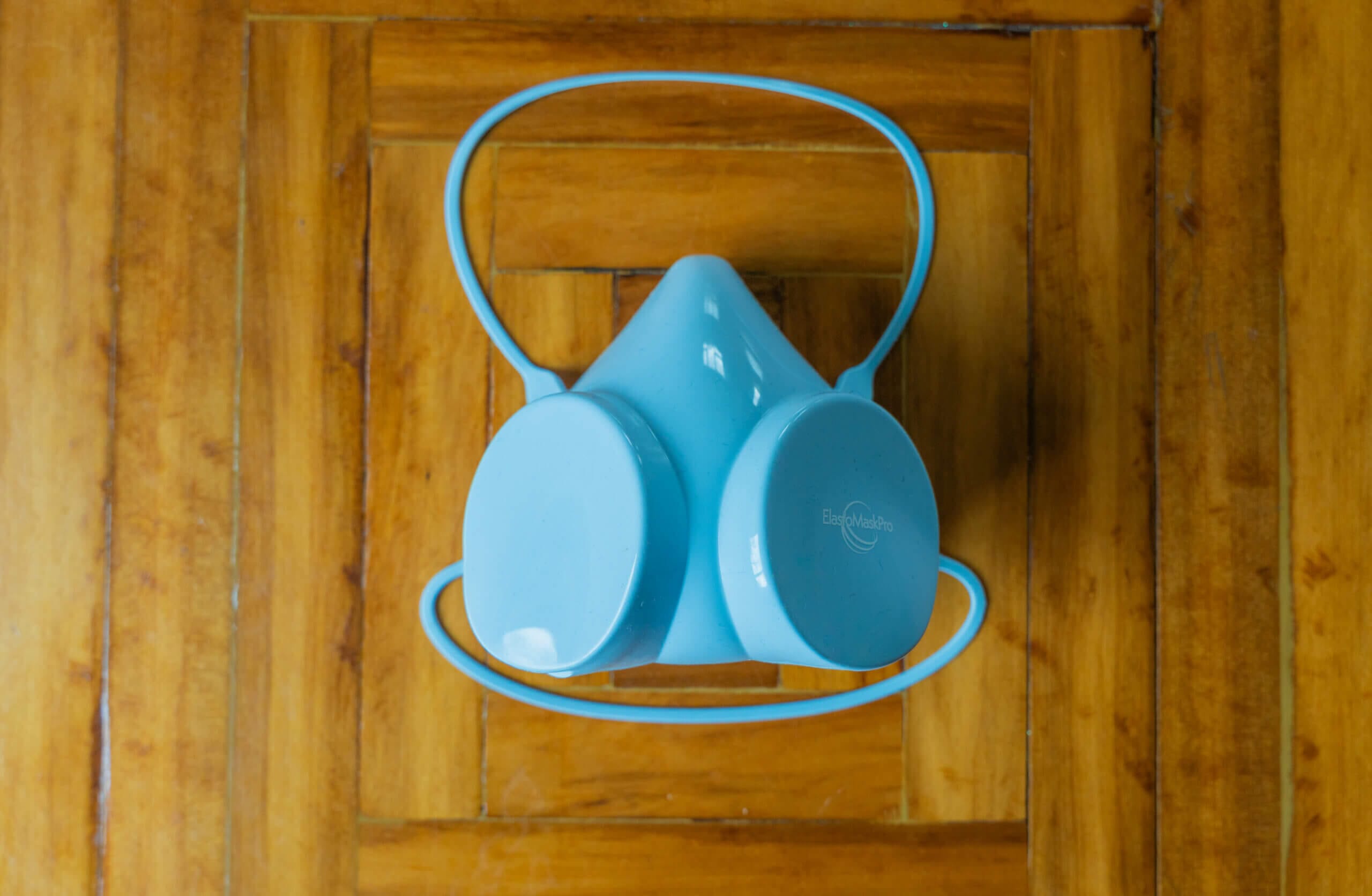
Brand: Reusable Respirators LLC
Filter Types: Particulate (N95)
Valve: No
Filter Attachment: Slot-in
ElastoMaskPro is a very different half-face respirator for a range of reasons. Firstly, it’s designed for medical use and therefore focuses on comfort first and foremost. While the mask doesn’t slouch on protection with an N95 approval, it focuses on remaining comfortable even after hours of wear. This makes it ideally suited for hospitals and other medical environments.
Secondly, it’s the priciest respirator on this list by a significant margin. Despite being one of the lightest respirators with a smaller form factor than the larger devices, ElastoMaskPro is neither cheap nor its replacement filters. However, the price is somewhat offset by the long-term cost of owning the product, which should come out much cheaper than relying on disposable N95 respirators.
I recently shared my full thoughts on the respirator in my ElastoMaskPro review. If you’re interested in hearing more details on this half-face respirator, I recommend checking out that article as it goes far more in-depth about my thoughts on the device. In this list, I will mostly focus on comparing it to the other included respirators.
ElastoMaskPro is not supported by a range of filter cartridges. As of the time of writing, this device is focused on being the most comfortable device in its class. To achieve this, N95 approval is a great middle-ground – it allows the filters to remain highly breathable while offering a good level of protection.
ElastoMaskPro follows Project BREATHE guidelines. Although these guidelines are not commonly followed, they were established around a decade ago to guide manufacturers to make more comfortable respirators that can be donned for hours without discomfort.
This half-face respirator has therefore focused on being extremely breathable (2-3x more breathable than most disposable N95 respirators), using comfortable materials, and having a comfortable mounting system. With all these focuses, I can safely say that ElastoMaskPro is the most comfortable half-face respirator I have tried.
Being medically focused, these respirators do not feature valves. While this can be an issue on some half-face respirators as exhalation resistance is significantly increased, it is not at all an issue on this product. Valves are simply unnecessary with the exceptional breathability already provided by the large, pleated filters.
The filter covers also allow the user to easily seal-check their respirator, similar to the Advantage 290. By simply pushing down on the seal covers, you can cover the filters and quickly identify any leaks around the edge of the device. This is a great feature when you don’t have access to fit-testing or are in a rush.
If you’ve tried a 3M 6000 series respirator, you will find a similar fit with ElastoMaskPro. The biggest difference between the two devices is the softer seal on the ElastoMaskPro – a welcome addition. However, overall the fit of the two devices is very similar; if one fits, the other should too.
My one worry with ElastoMaskPro was the strength of the elastic headbands over time. However, the team behind the respirator has extensively tested the longevity of these headbands and shown that they should last over 100,000 extensions.
Overall, ElastoMaskPro is a great half-face respirator where comfort is the priority. With N95 approval, the device doesn’t offer as much filtration as other products on this list. However, in most situations, N95 is adequate, and these are the situations in which ElastoMaskPro excels.
ActiveMask
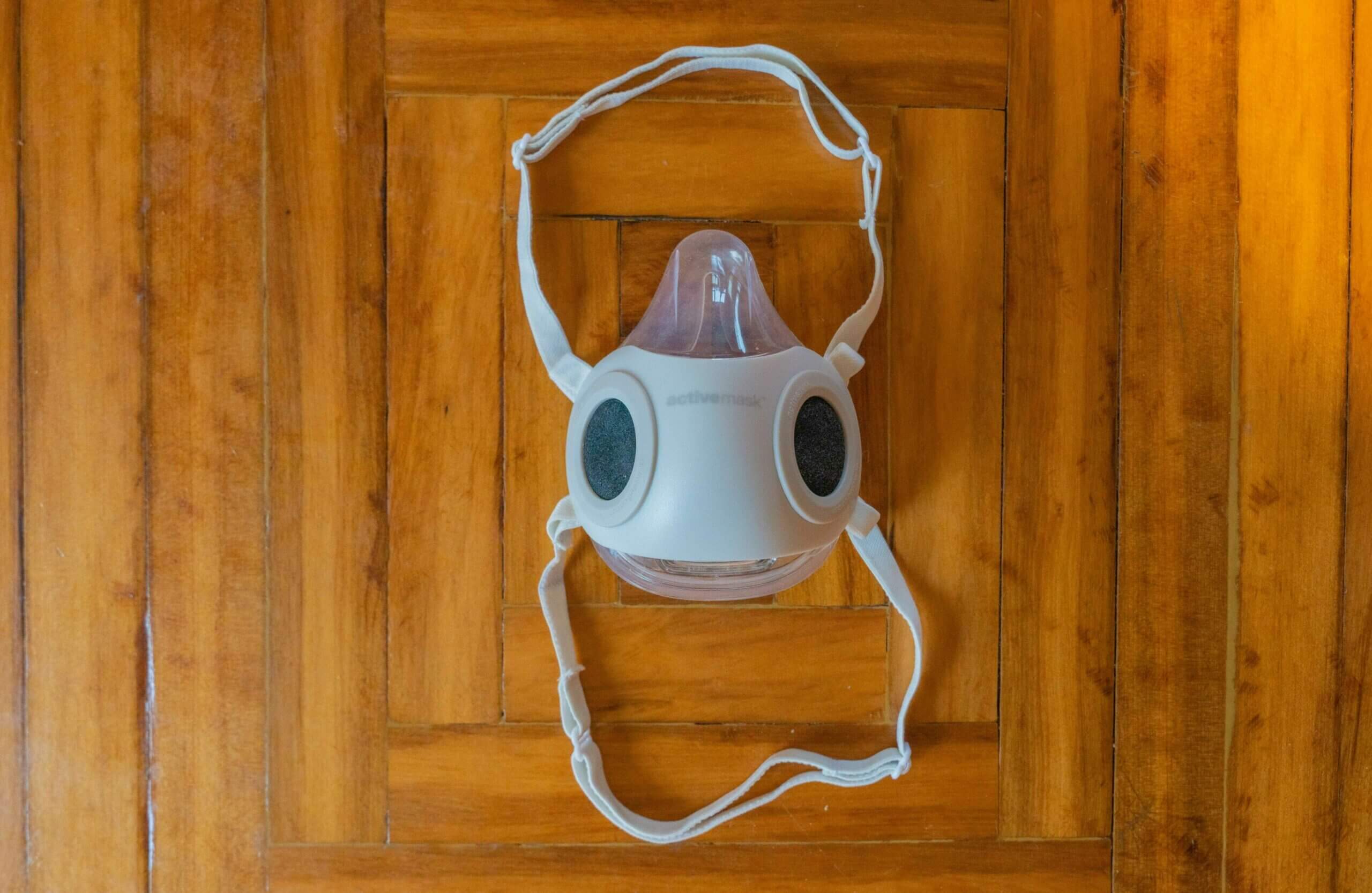
Brand: ActiveMask
Filter Types: Particulate (P2)
Valve: Yes (comes with a partial cover)
Filter Attachment: Twist
Unlike every other half-face respirator on this list, ActiveMask is not NIOSH-approved. Instead, the Australian mask is certified P2 – the rough equivalent to the N95 standard in Australia and New Zealand. For more details on the differences between the standards, I recommend reading this article where I compare respirator standards.
On top of the P2 approval, Activemask has also been approved by the Australian Government’s Department of Health Therapeutic Goods Administration as a half-face respirator. ActiveMask is classified as a medical device (Class 1). This is Australia’s equivalent to a medically-approved N95 half-face respirator.
If you’re interested in reading about the performance of ActiveMask, I recommend checking out my ActiveMask review. In that, I dive into far more detail regarding the filtration, fit, comfort, and even pricing of the respirator. However, for a brief introduction, read on!
As you’ve probably already identified from the photos, ActiveMask is a small form factor half-face respirator. In size, it’s more akin to a quarter-face respirator such as Envo Mask. However, since ActiveMask seals further up the nose, it is considered a half-face respirator, albeit it is far smaller than larger models such as the RU8500.
This small form factor has both benefits and drawbacks. On the plus side, the smaller form factor means the respirator is lighter and (in my opinion) significantly easier to wear. If you’re wearing the respirator in public, it’s also far less likely to draw attention than the larger respirators on this list.
However, the drawback is the seal on ActiveMask isn’t as solid as the larger respirators. Although I could get a complete seal on ActiveMask, I was never as confident in it as I am in the seal of the larger devices. With that being said, I praised the fit of ActiveMask in my review, and I believe it performed very well for a small form-factor half-face respirator.
On the objective side, unlike the NIOSH standards, ASNZS1716 requires total inward leakage testing on a variety of subjects In the fit testing, the respirator is donned by a variety of people who perform different actions such as talking, walking, and turning their heads left and right. Across all samples performing all actions, leakage on ActiveMask never exceeded 4.3% (≤ 8% is the requirement for P2).
This objective fit testing shows that ActiveMask fits a variety of individuals well and is capable of sealing with minimal leakage. From my own experiences, I found this to be the case, and I was impressed with the fit of ActiveMask – especially when considering the size of the respirator.
Due to the use of Lanaco’s wool filters, ActiveMask is also highly breathable. At a flow rate of 30L/min, the respirator had a pressure drop of 24-33 Pa. At 95L/min, the breathing resistance increased to 114-142 Pa. Although these results aren’t as impressive as ElastoMaskPro, they still show the half-face respirator is highly breathable.
Regarding the other comfort aspects, ActiveMask is one of the most comfortable half-face respirators. The seal is very soft, ensuring that it doesn’t cause irritation or a bad case of ‘mask face’. Further, although the headbands are relatively small, they support the weight of the respirator well and don’t cause pain.
Despite being a medically-focused device, ActiveMask uses an exhalation valve located at the bottom centre of the mask. This valve is open by default, and exhaled air will exit through it. However, carbon filters are included for anyone looking to add partial exhalation filtration. However, it’s worth noting that these filters aren’t as capable as the inhalation filters.
Finally, it’s important to mention ActiveMask does not have a range of filters that can be used with the respirator. Currently, the half-face respirator can only use the P2 filters supplied with the product. Therefore, this respirator is only intended for particulate filtration.
Purchase ActiveMask Respirator
Have Questions or Comments?
Join the discussion on the BreatheSafeAir Community Forum. Ask any questions you have about air quality or adjacent topics and get quick answers!
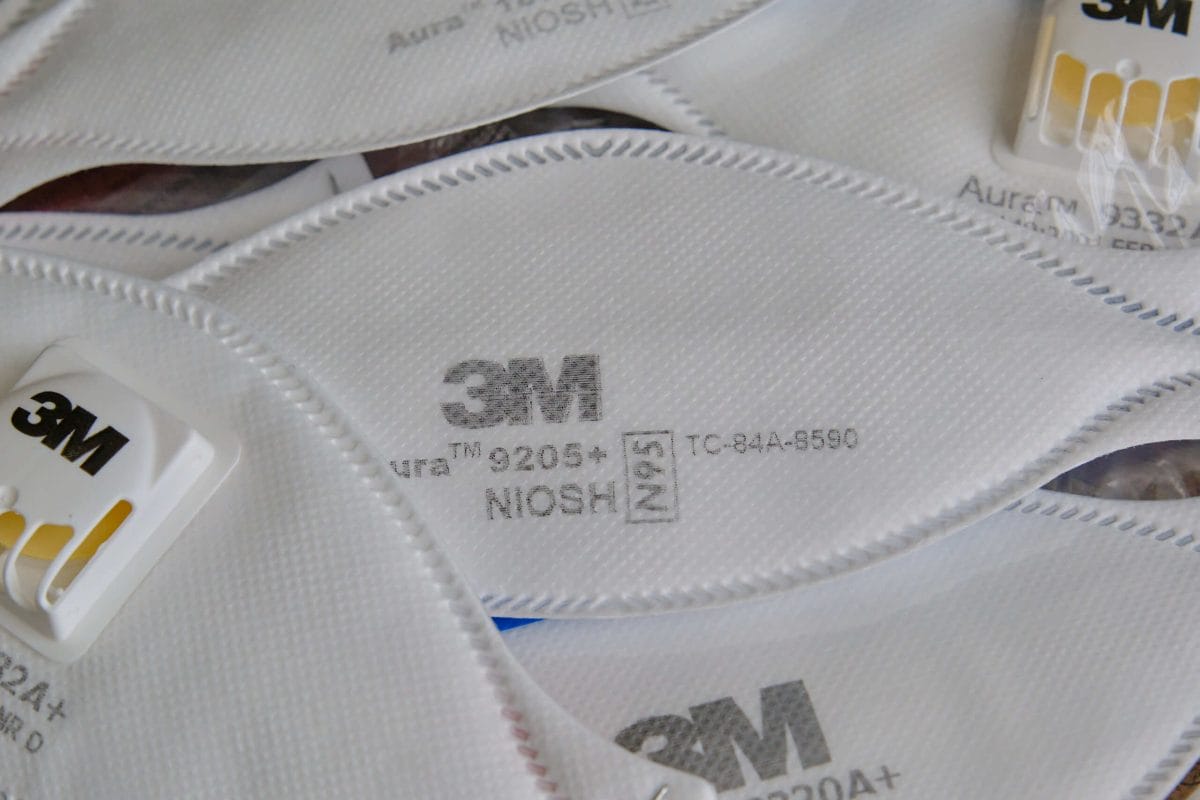
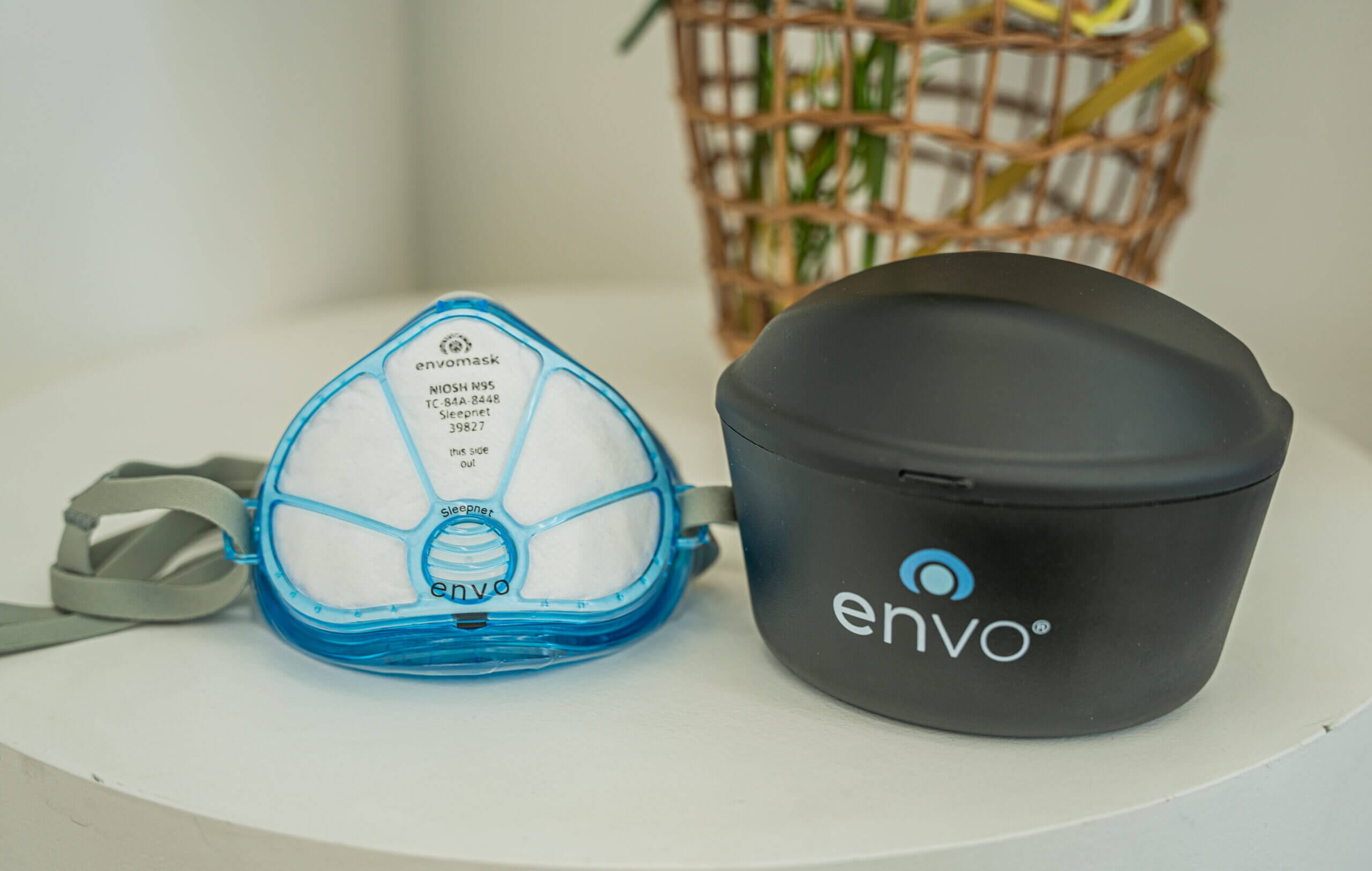
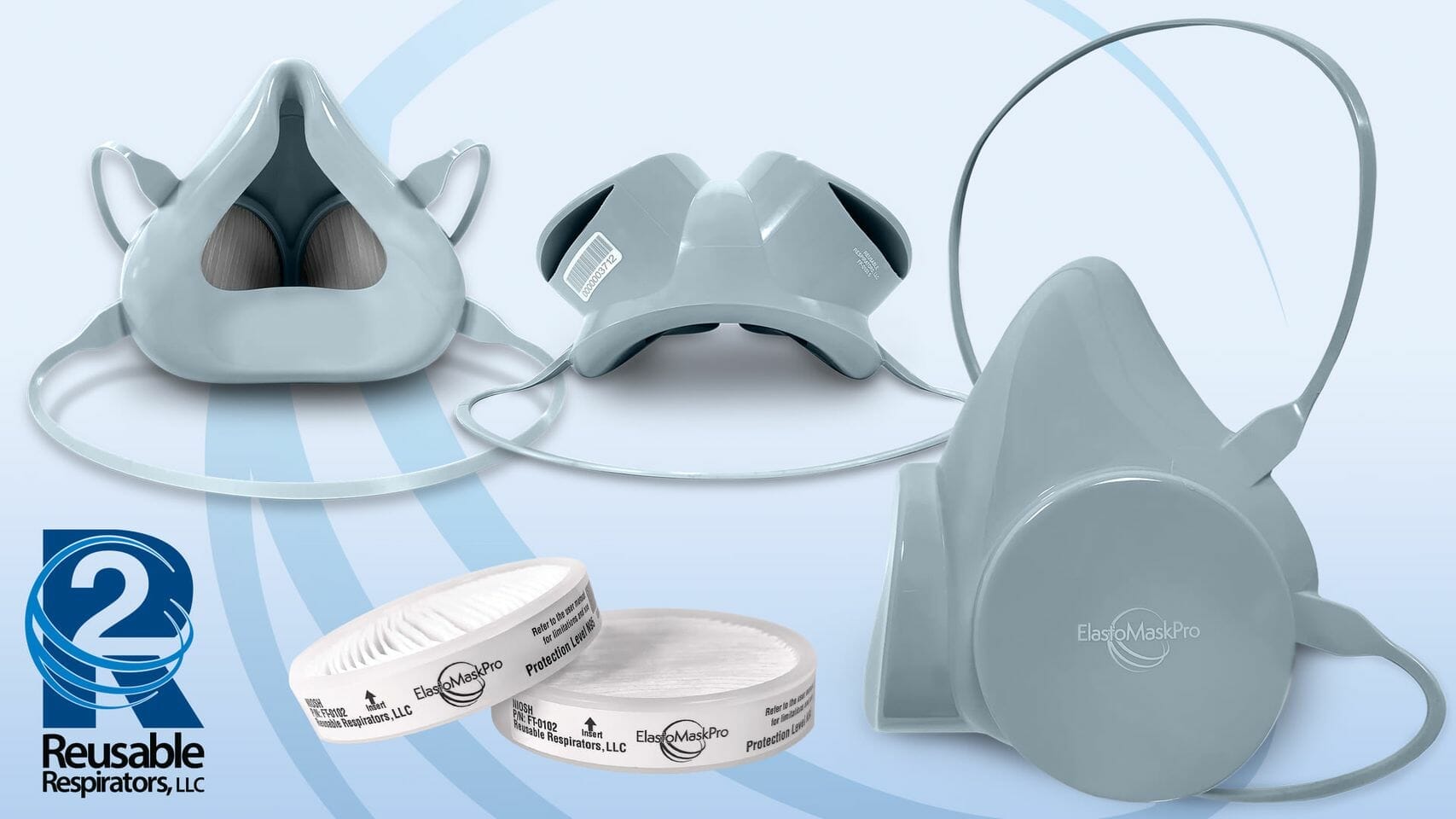
I found out difficult to purchase this mask other than through the website in asking for a quote. I managed to get one and it’s not too bad, however, tends to pool with condensation. The second issue I have is although the mask is the correct size, the way the head straps fit in is not great, so I cannot get the bottom straps to go around my neck properly without the straps coming out from the clips. This is due to the direction the straps need to go and the way they clip in to the plastic holder.
Hi Jessica,
Which mask are you talking about?
I feel like you’re talking about the ActiveMask as this has been my experience with it. I also had zero luck purchasing it through the companies website and never received a reply by phone or email about purchase.
I was able to source one through Central Height Safety (not an endorsement or affiliated with them in any way).
I have worn the active mask daily since September 2022, usually for over 8 hours at a time. This covers my travelling into the city, time in university and time in the office at work.
I can speak to its comfort, breathability and (anecdotally) capacity to filter. I upgraded to a mask that could meet the requirements of being worn daily, was comfortable, was sustainable in that the filters are made of wool, and protected me from COVID-19.
Again, not medical advice, and only anecdotal:
In the 5 months I have used this product I have change the filters four times, and spent hours per day around coworkers, students and general crowds without contracting any form of illness. This has included several rounds of people in my direct vicinity showing up to work with symptomatic COVID-19, RSV, Strep and coughing constantly.
I rate this mask highly, though note that I also mitigate risk with behaviour (don’t remove it unless at home, air purifiers, Stoggles, CO2 monitor, etc).
The mask cost me $89.00 AUS and I have been able to order replacement filters through the supplier above. I find it more comfortable than 3Ms Auras, and have had minimal issue with people staring or comments. The straps for the head are a bit like bra straps, and I ended up sewing them shorter to increase the seal. I also find the filters last longer (ie less obviously worn) if I use extra layers of fabric to create a shield on top of the carbon. I have also experimented with cutting 3M filters to fit into the filter slots to great effect.
Here’s to hoping it works for others and thank you to this website for introducing the brand to me.
Hi Jaime,
Can I just confrim whether you found it helpful for stopping chem and fragrance smells coming through? Without or without your extra layers (great idea BTW).
Thanks
Hi Aami,
I haven’t used it too much around chemicals. Having worked in industry with commercial chemicals before I always swap to my 3M half face respirator.
As for smell, I didn’t really notice any significant change to scents compared to being unmasked. I first thought about that when I brought a scented candle to my nose out of habit to smell (with the mask on). There was no impact on my ability to pick up the scent. That being said, that was something up near my face and there may have been many smells (chemical or otherwise) that I didn’t notice because of the filters.
I’ve since changed to a Flo Mask as the nose on this one split and the replacement soon split at the base. I still rate the mask but I find the Flo Mask easier to breathe through (bigger filters) and there’s been a bit of a social change in Aus where I was a bit off people coughing at me or pointing at the mask and laughing in public. With the Flo I can wear the black front, add black fabric and very much adopt a “get out of my face” look.
Whoops, sorry Ethan! I was referring to the Activemask.